Do people need a new social media app?
Well, this is the question you might be bothered by as an entrepreneur or an organization. You should be aware of the current social media trending apps and how they are capturing users’ interest.
Creating a new social media app should be just like providing a breath of fresh air to the people. This is possible only when you explore an opportunity and a gap in the market.
That’s where your app will stand out among the competitors.
Are you ready to go the extra mile?
Now the question arises “How to create a social media app?”
Let’s dive into this guide to make a social media app. Here, you will find all your answers.
What is a Social Media App?
Social media: A world that has strengthened the brand’s marketing, helped them to reach the target audience, created a space for people to connect digitally, and a lot more.
It has almost changed the lifestyle of people, hasn’t it?
We know well that you must be aware of the concept, but let’s polish it once to bring a change.
According to Wayne Dyer “If you change the way you look at things, the things you look at change”
Social media refers to the means of interaction among people, and an app provides them a platform to share information and ideas within virtual communities as well as networks. People use these apps to stay in touch and interact with friends, family as well as various communities.
We think that this definition has cleared enough about social media apps. Now it’s your turn to jump off the steps to develop a social media app.
Let’s get ahead and hit the ground running.
How to Create a Social Media App in Simple Steps?
Creating a social media app is all about discovering the right series of steps to undertake the same.
How to develop a Social Media App?
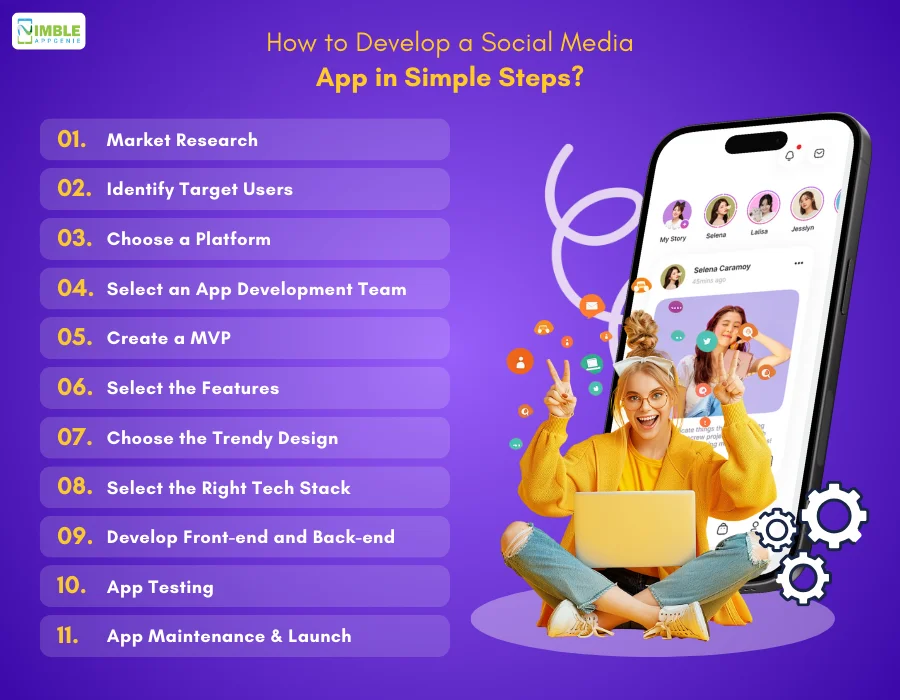
Here are a series of steps to consider for developing a social media app.
Step 1: Market Research
One of the most significant steps within the development of a social media app is market research. Before you initiate the technical aspects of making a social media app, conduct a thorough market research.
Under this process, with the Motion analytics alternative, you can analyze the competitors’ app and their strategies to engage users successfully. This will help you to evaluate the current scope of the market and an opportunity for capturing users’ interests.
Step 2: Identify Target Users
There are different types of social media apps present in the market, some are concerned with professional connections and photo and video posting sites, and some of them are designed to conduct chats.
Thus, building the target users’ personas and journey mapping is one of the processes to undertake within this step. It will assist you in identifying the target users and planning strategies to capture their interest.
Step 3: Choose a Platform
It is vital to select a platform on which the app can be launched. Here you need to select between an iOS app or an Android app. Please note that selecting one platform at a time may decrease your cost for a while but does limit the number of users. By evaluating the target audience, you can fetch the right technical requirements for your application.
Step 4: Select an App Development Team
After finalizing this kind of social media platform and your target audience. It’s time to hire app developers to create your dream app. In this step, you should be able to evaluate the developers’ location and specialization in the context of your app.
Along with this, you should be able to identify the time of medium helpful to communicate effective strategies and their ways to deal with the project. It is the most important step because here you will hand over your dream app to the team who can develop it in the best possible way.
Step 5: Create an MVP
Now, it’s time to develop a minimum viable project with your selected development team. It’s all about developing a project with the core and minimum features and then launching it in the target market. MVP can be stated as a product that is enough to attract adopters.
After launching an MVP, you can effectively identify how many users your launch MVP can attract and what their views are on the same. This step will help to save the overall cost because here you can track the users’ dynamic demands.
Step 6: Select the Features
Well, within the process of developing an MVP, you will be required to select the core and advanced features. However, you will launch the MVP based on core features only. This is an essential step, where you will finalize the functions of the app.
Features will define how your app will stand in the competitive landscape. Hence, this step should be considered very carefully because here you will decide what your app will offer to the target audience and how it differs from the one present in the market.
Step 7: Choose the Trendy Design
You should select a UI/UX app design that will capture users’ interest in one go. This is the first impression among the audience, hence this step should be according to the users’ preferences and to capture their attention.
Here, the app design should comprise the kind of color, theme font style, etc. You should create a social media app design based on the interests of the users. Here creating a prototype and wireframe can help to select the based and trendy designs based on current users’ preferences.
Step 8: Select the Right Tech Stack
Choosing the right tech stack is all about selecting the right database, programming languages, and front-end and back-end tools. In selecting the tech stack, you should consider the major purpose of the social media app and then assess the right programming languages.
Your targeted social media tech stack can be selected depending on the type of feature, along with the type of platform you want to choose. Here, you should analyze different types of features, because it will help to discover effective programming language.
Step 9: Develop Front-end and Back-end
Now, it’s time to develop a social media app with the right guidance through designing the front-end and back-end of the application. Here you will be required to develop a front end that your users can see and includes virtual elements such as buttons, graphics as well and text messages.
Additionally, you can develop backend data as well as infrastructure that can make your application work. Here, you can store users’ data and can process it based on the requirement. This is a very important step under which the whole app development process takes place.
Step 10: App Testing
Mobile app testing is an essential step to look for within this process. Avoiding it can lead to harmful consequences. Here you should perform thorough testing by analyzing current users’ experiences specifically for the new users.
One of the important benefits of the testing here is that it ensures that the app works smoothly and can satisfy all the users’ requirements. Additionally, you should check that the app works on multiple devices and the targeted platforms.
Step 11: App Maintenance and Launch
If you wish to get ahead of your competitors, notice that it’s important to have a launch date. You should not postpone it, because by doing so your target audience can discover a new brand or app. With rigorous testing and implementing user feedback, you should perform an app launch.
Here, considering pre-advertising for an app launch can help capture the interests of targeted users. Additionally, after launching the app, you should go for app maintenance services. This is the most vital process to sustain the competitive environment.
These were some of the important steps to build a social media app that you shouldn’t skip.
Now, as you get ahead with the process, let’s learn what kind of social media apps can be a handful for development.
Are you ready to check the next section?
Types of Social Media Apps
There are different types of social media apps that you can evaluate and build based on the users’ requirements and market demand.
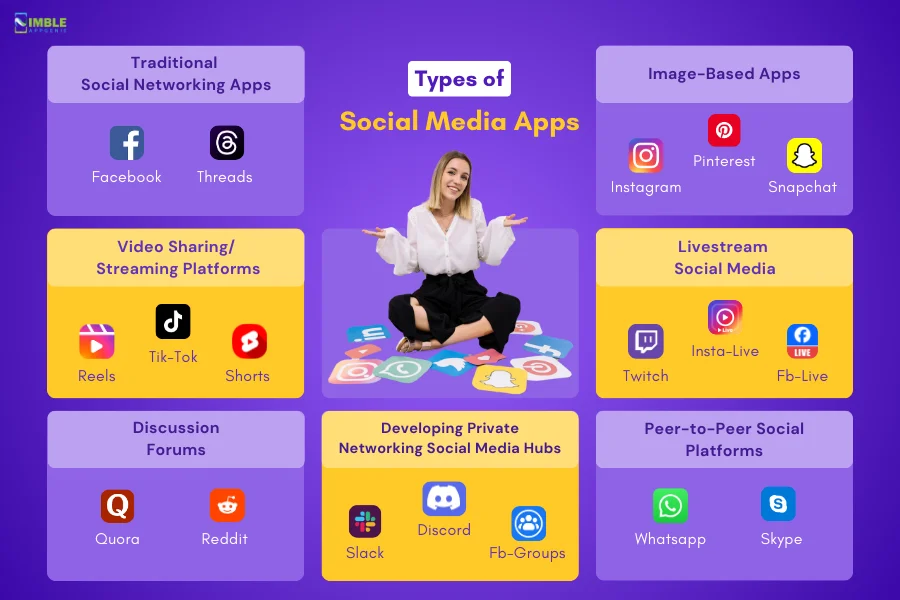
Here’s a list that can help you with providing ideas to create a social media app.
♦ Traditional Social Networking Apps
Traditional social networking sites are used for connecting users directly within specific areas as well as communities.
These sites are developed to focus on person-to-person conversations. Additionally, such platforms are built to encourage social sharing.
Such platforms are flexible and gather a lot of information related to their users. Here you can run specific ads targeting the users.
Examples: Facebook, Threads.
♦ Image-Based Apps
Image-based as well as video-based types of content have gained prominence in the recent era. These applications might comprise computer vision as well as artificial intelligence.
Here the content like infographics, illustrations as well as images captures the attention of the users more.
Because a picture is worth a thousand words. This can have lots of positive effects. We encourage your audience to generate unique content as a way of engaging with your brand.
Examples: Instagram, Pinterest, and Snapchat
♦ Video Sharing Streaming Platforms
Video content is the most captivating form, brands can use this form to reach their target audiences effectively. These kinds of platforms have helped to attain a large audience and a loyal user base for brands.
People search for all kinds of videos which are great for driving brand awareness as well as bringing products to life.
Here you should note that any kind of video content that you publish over the platform should entertain the users as well as inspire them to create more irrespective of harming anyone.
Examples: Instagram reels, TikTok as well, YouTube Shorts
♦ Livestream Social Media
Livestreaming platforms have exploded during the pandemic era. With these kinds of applications, users can upload content live streaming video content in real-time.
Here the audio and video data is compressed, encoded, as well as broken up into smaller data packages.
These platforms assist users in broadcasting real-time video content to directly influence their users.
Examples: Twitch, Instagram Live, Facebook Live
♦ Discussion Forums
You can master the discussion forms apps by developing them and providing a platform for the users to discuss their opinions with like-minded people effectively.
These are virtual discussion boards where the users are allowed to post questions as well as comments for sharing the information.
Here you can allow users to post an expression or view to allow them to post a topic that is reviewed or can be contrasted by anyone at any time.
Examples: Quora, Reddit
♦ Developing Private Networking Social Media Hubs
These are the groups that are developed to bring the community members together. You can create these kinds of private platforms to engage the users.
You can create a social media app that comprises private networking hubs for engaging users as well as running contests and promotions to add value to the members.
These are private social networks that creators and members use to form public social networks.
Examples: Slack, Discord and Facebook Groups
♦ Peer-to-Peer Social Platforms
A peer-to-peer social network is an online platform where users can directly connect, without the need for a third-party server.
Here users can connect with their friends and relatives directly. Within this type of platform, P2P technology can be used to perform instant messaging applications.
Over this platform, users can conduct instant messaging services in real-time.
Examples: Whatsapp, Skype
These are some of the types you can look for while building a social media app.
Well, are you still bothered about why you built a social media app?
Let’s cover all the reasons in the next section.
Why Build a Social Media App?
Are you still confused about whether to build a social media platform or not?
Well, the given section within this guide to social media app creation will address all your doubts.
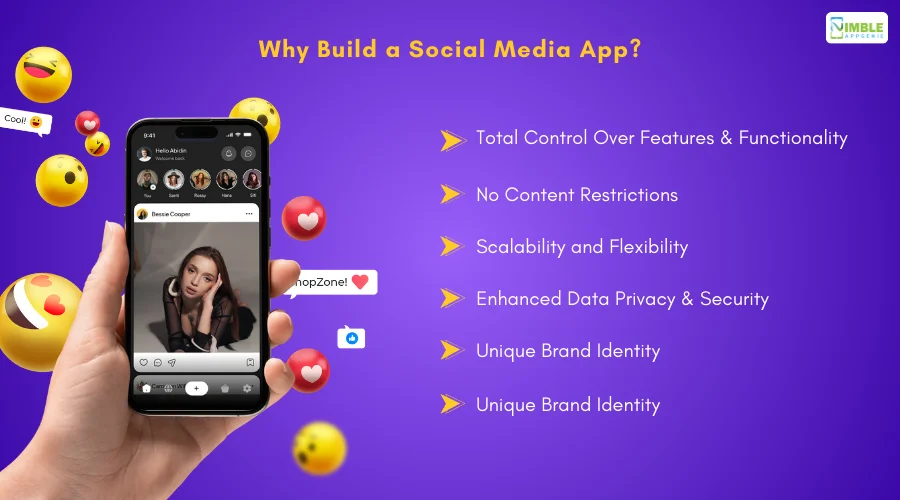
-
Creates Brand Awareness
Making a social media app can help develop awareness about the brands and organizations among people.
Through different kinds of social media platforms tools, you can help small and medium enterprises to increase their brand image.
This will assist you in having a permanent source of monetization models.
-
Growing Users’ Demand
Within 2023, an estimated 4.9 billion people use social media platforms across the world. Facebook has become a market leader within the social media market and is one of the foremost platforms to cross 1 billion registered users.
YouTube currently has 2,504 monthly users. Are you ready to be one of the leading platforms?
Well, that’s why you should proceed with the steps to create a social media app.
-
Bringing a Revolution
Identifying the current gap in the social media market and coming up with an app that can create a revolution may assist you in being the leading brand.
With an innovative idea after discovering the market, you can bring a revolution within the industry. This is an important reason to consider here.
You can check on the growing number of users across the network and then decide which type of platform is required in the current era.
-
Connecting Users
One of the main objectives of the social media networking platforms is to connect the users.
These platforms assist in maintaining relationships and assist to foster a sense of belonging and self-esteem among the users.
Thus, you should build a social media platform to connect the users and help them to build further connections. Via the app, you can create a space to engage users across the platform.
-
To Earn Money
Do you want to earn money via app development, then developing an app like WeChat can help.
If you create a social media app that can fetch target users, then it can become an effective way to earn high amounts and generate permanent revenue.
With the right steps to create a social media app, you can implement multiple monetization strategies such as advertising, in-app purchases, data monetization, etc.
-
A Source of Entertainment
Do you know, that people have spent over 151 minutes on social media platforms in 2023?
Well, it’s true. You must have seen people scrawling social media apps that display their engagement across the platform.
To develop a social media app, all you need is the right sequence of steps and features that can create engagement.
Well, these were the reasons to be considered. Now, to build a social media app, you must be aware of the features as stated.
Are you ready to learn about them?
Let’s study them all in the next section.
The Must-Have Features for Social Media Apps
What are the significant social media app features to include for a successful social media app?
How to make a social media app?
Well, we have already stated that selecting the feature is among the most important steps to create a social media app, right?
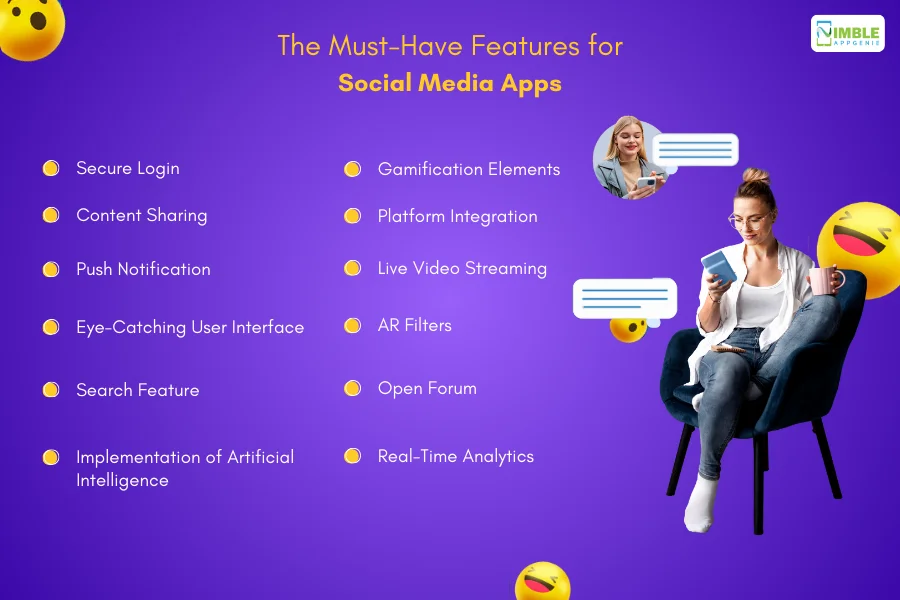
Let’s go ahead with all of them, here.
1. Secure Login
Users of social media apps add a variety of data publicly and privately. Thus, it is essential to integrate the app with different devices.
A secure login assists users in having a familiar sign-in method as well as reduces cognitive load across the brands.
With authentication, users can accept permission from the app or the site once the social provider confirms their identity.
2. Content Sharing
This is one of the most basic features of social media apps. Well, the ultimate purpose of developing a social media app is content sharing, right?
This feature facilitates communication among different users and provides them with a space to connect. It encourages referral traffic as well as enhances content engagement.
Thus, you cannot think of creating a social media app without including this feature.
3. Push Notifications
Do you wish to hook the users up for a longer interval?
Well, push notifications can help here. With a ping over a smartphone, you can encourage them to look for any updates or messages.
This feature not only engages the users but also keeps them informed about any important updates that may require immediate response or reaction.
4. Eye-Catching User Interface
One of the important features is an eye-catching user interface. The UI/UX of your app should build an engagement that needs to be captivating.
Additionally, the interface should be easy to navigate and understand for the new users.
People tend to like the app that helps them to access their demanded activities without any hassle. Thus, your app should promote such a vibrant ecosystem.
5. Search Feature
If you want to make your app less complicated, it must comprise a search feature. With this feature, you can reduce the users’ time to find and select any post or activity they want to fetch.
Your app should make your users’ journey smooth and simple. Thus, this feature will help them to successfully reach out to the people, posts, or communities and connect with them without any errors or mistakes.
This feature provides convenience over personalized as well as relevant content.
6. Implementation of Artificial Intelligence
AI in social media apps has boosted users’ journey with the brand. This feature can make users’ search simple.
There are many other benefits of using AI features during the development of a social media app such as it will help in facial recognition, helping against data and identity theft as well as detecting any spam.
Using this feature within the app can provide you with an opportunity to help users with the content as well as analyze data.
7. Gamification Elements
Adding gamification elements to the company’s website will add value to the customer. This element helps to enhance participation, and motivation as well as provides many benefits irrespective of the industry as well as the company’s size.
You can access the beauty of gamification as it helps to enhance participation and motivation as well as provides many benefits regardless of the size and industry of the brand.
Additionally, the gamification elements make social marketing campaigns more engaging as well as interactive.
8. Platform Integration
Another effective feature to add to social media apps is platform integration. You should integrate social media platforms because they allow you to connect with a broader audience.
After adding APIs to social media apps, you can get users’ insights on where brands can use these platforms by increasing followers, enhancing brand visibility as well as driving traffic.
Integrating different platforms with social media is essential for increasing engagement and driving leads.
9. Live Video Streaming
Over live video streaming across social media networks, users have the opportunity to connect with prospective leads as well as communicate.
Live video streaming is a type of real-time video that is shared over the internet, who can submit written comments as well as questions throughout the podcasts.
This is an important feature that encourages entertainment and embraces brand visibility.
10. AR Filters
Apps such as TikTok and Snapchat help users take pictures with AR filters. These apps make users’ interfaces more interactive.
In the current era, location-based AR filters within social media apps are helpful in brand marketing.
Through this app, brands can bridge the gap between real-world interaction as well as online marketing.
11. Open Forum
Open forums are an important part of social media because they can assist users in connecting with different kinds of people which helps businesses to promote their brands.
These forums are virtual discussion boards where they can post comments as well as questions to share information about specific interesting topics.
These kinds of forums are useful for gathering information or interacting with the members of their communities.
12. Real-Time Analytics
Real-time analytics as well as insights within the app is effective for you to identify the changing users’ behavior.
This feature is helpful within social media apps for performing real-time communication.
These kinds of apps assist in tracking user engagement and how much time they spend on the app. This will help you to provide a dynamic view of social media activity.
These are some of the features that will be helpful to enhance the overall functionality of your app. Now, if you’re struggling with how to implement it and what it can offer.
Consider the inspiring story of popular social media apps in the following section.
Learning from the Best: Inspiring Social Media Apps to Study
Want to develop an app like Snapchat, well you can do so by evaluating their competitive strategy.
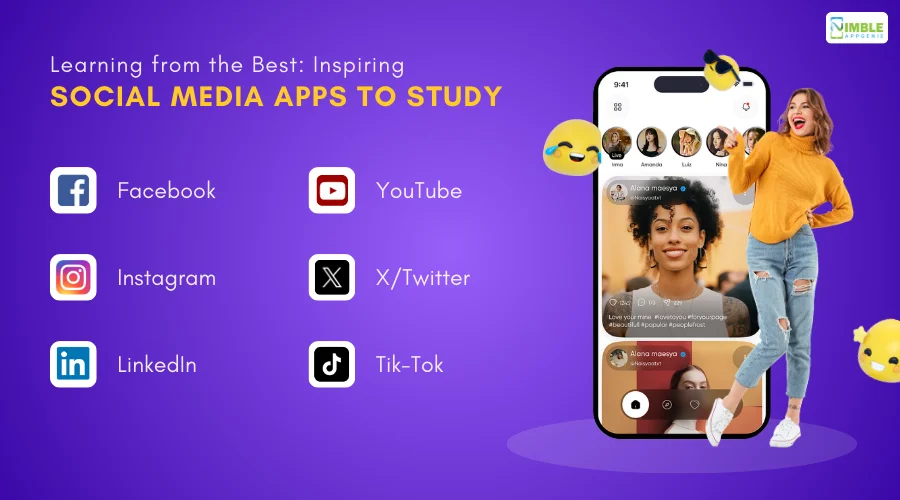
Learn more about the best social media apps and their strategies to capture the interests of the wider population below.
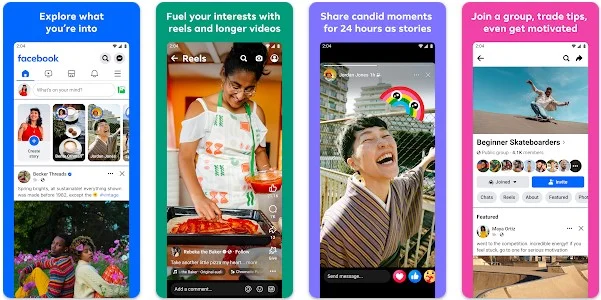
Wish to develop an app like Facebook?
Well, in the current era, the number of users on the platform is three billion monthly. With its features such as interactive news feeds, and AI and AR filters, the app creates engagement.
This platform helps users to maintain a friends list and form connections.
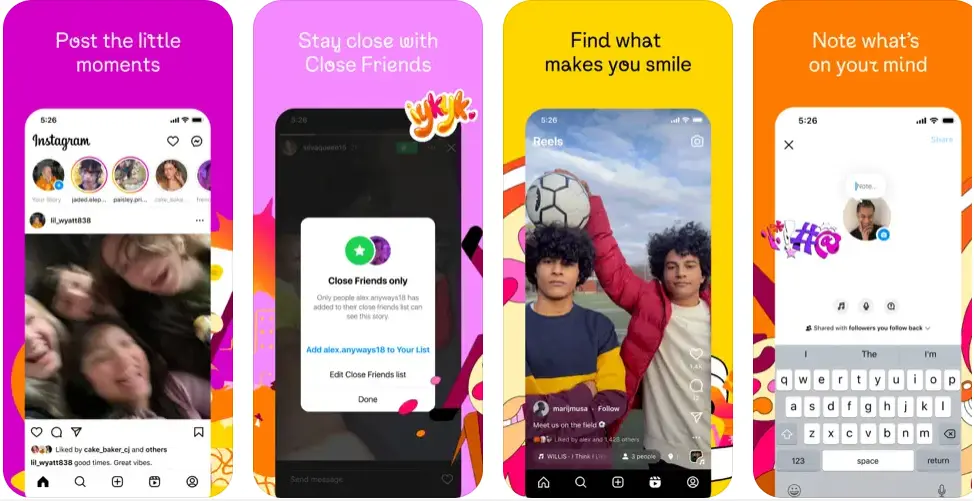
You can develop an app like Instagram which is an interactive social media and is a free video as well as a photo-sharing app which is available over iPhone and Android platforms.
The app comprises various engaging features such as stories and direct messaging, where users can discover different kinds of tabs for exploring content.
Its amazing features assist in measuring how people interact with your content and interface.
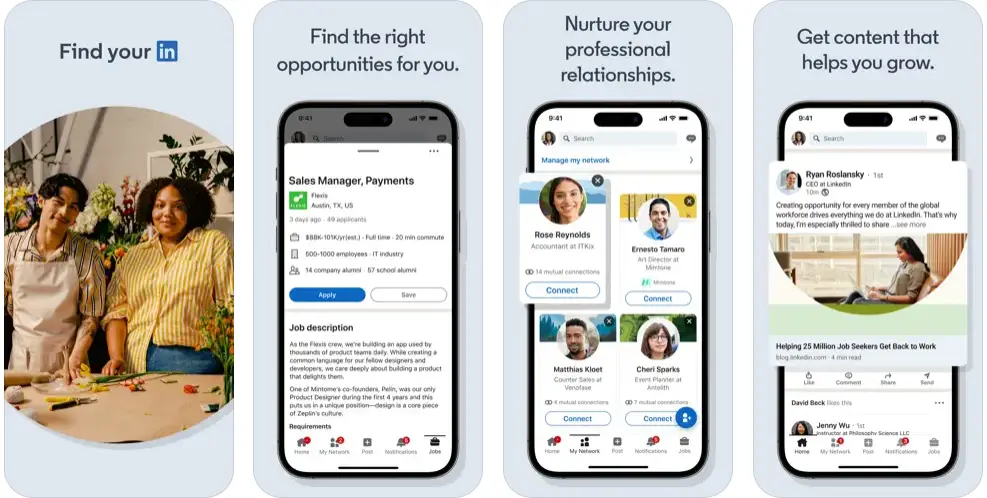
LinkedIn has become one of the best and largest professional networks. Do you have an account on LinkedIn?
Well, this shows the popularity of the app in the current world. Another critical factor that engages the users is the user interface.
Additionally, the platforms’ marketing strategy contributes to the success of this network.
► YouTube
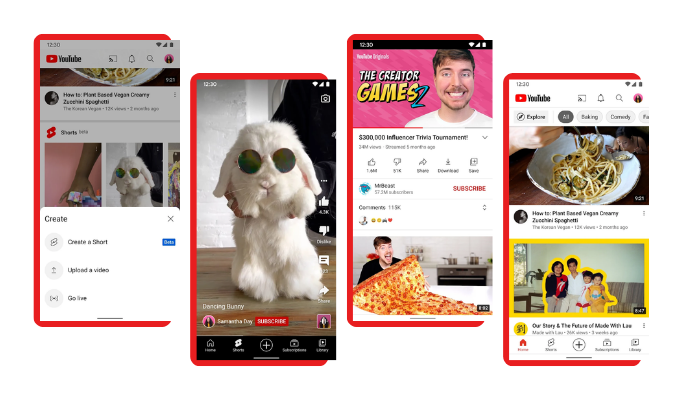
Based on the data from Statista, the global number of users over the platform is expected to increase between 2024 and 2029 by a total of 232.5 million users.
This is one of the most important media that supports video content and engages users successfully.
Here users can access an unlimited number of videos over the website. You can develop an app like
► X (Formerly Twitter)
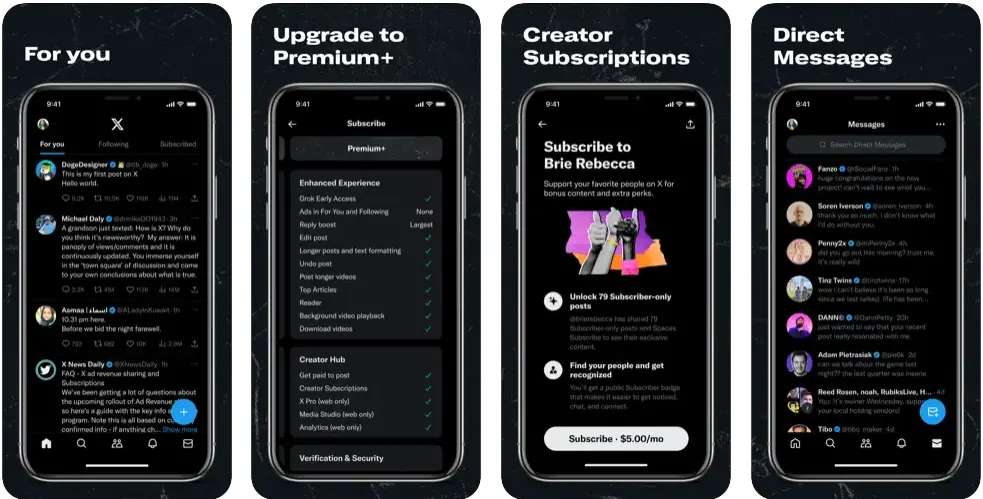
To develop an app like X, you need to know what makes it so different from competitors.
Its microblogging service can be the answer to your question. It is a combination of blogging as well as instant messaging.
Here, registered users can post and share as well and are allowed access to short messages to post a reply.
► TikTok
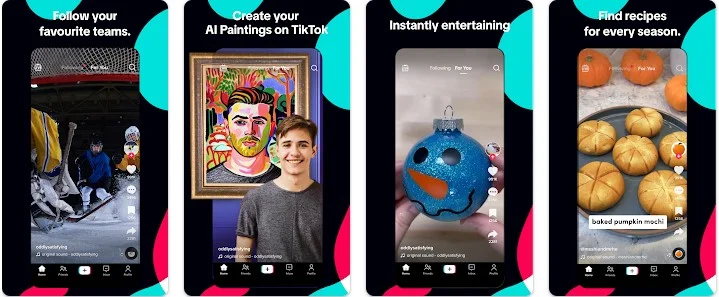
TikTok has become one of the leading destinations for accessing short-form mobile videos. One of the crucial missions of the platform is capturing the current world’s connectivity.
This is an engaging platform useful for creating, sharing as well as discovering short videos, effectively.
You can develop an app like TikTok, by discovering its multiple effective features such as filters, streaming media, etc.
These were some of the top apps for inspiration, you can check their development process and cost to know more.
Now, as you get an overall idea related to how to make a social media app, let’s count on the cost figure in the following section.
Bonus Read: Best Social Media Platforms to Explore
Cost to Build a Social Media App
When you start with the steps to make a social media app, one of the questions that strikes is how much it will cost, right?
Well, the Average cost to develop a social media app ranges from $30,000 to $350,000. This cost is further impacted by different factors such as complexity, size, maintenance, platform selection, etc.
Thus, please note that mobile app development cost depends on understanding the type of factors and how they impact your estimated budget.
Apart from the above cost, it is essential to consider the challenges that you might face during the app development process
Overcoming Obstacles: Practices to Avoid Challenges in Development
If you want to compete with existing players in the social media market, it is vital to understand the mistakes to avoid while developing a social media app. Let’s learn them all here.
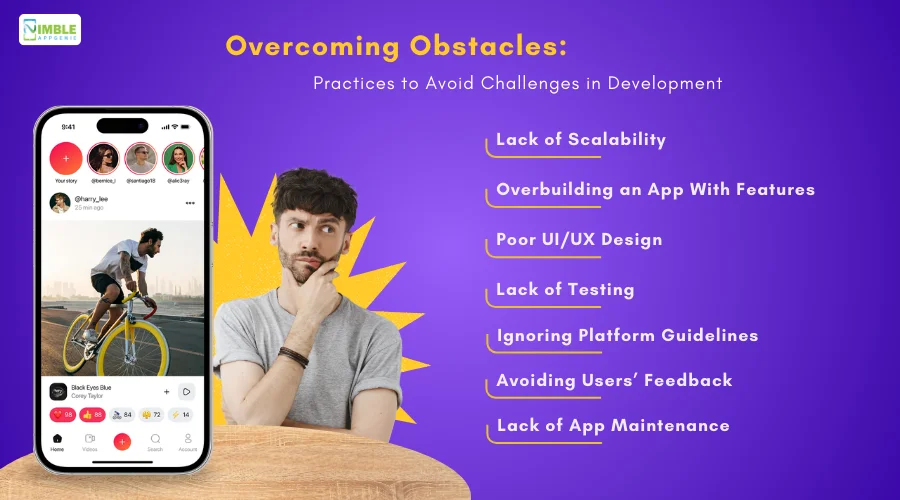
1] Lack of Scalability
If your app lacks scalability, then it’s an issue, thus, you should evaluate this feature and try to include it in your application.
The social media app needs to be scalable and required to handle a potentially massive user base with a high volume of data.
2] Overbuilding an App With Features
Do you want to address users’ needs and add too many features in this respect? Well, then the most considerable mistakes to avoid while creating a social media app. An app with too many features seems cluttered and it can confuse the users.
Thus, you should avoid this mistake. Implementation of minimal features that are simple to understand should be considered here.
3] Poor UI/UX Design
Your application must be able to attract users successfully. Poor UI/UX app design can impact the overall brand reputation of the app.
App design is the first impression among the users. Thus, you should build a social media app design that can be able to engage the users from the first step to download it.
4] Lack of Testing
If you are launching an app without any testing process, it’s important to avoid this mistake. Lack of mobile app testing will lead to major errors.
Along with this, the users will not be able to access the application successfully. Thus, you should minimize their efforts by making their journey seamless.
5] Ignoring Platform Guidelines
Is your platform license updated? Well, then you should be bothered by this issue. Ignoring the platform guidelines can impact the overall development process of social media app.
Here you should consider the guidelines for iOS and Android platforms along with what it takes to have a hybrid app launch.
6] Avoiding Users’ Feedback
Are you not including user feedback within your app while developing or updating it?
Well, this can become a major issue in this case. Including users’ feedback within the app will provide value to the users and will improve the steps to create a social media app.
7] Lack of App Maintenance
Want to stay in a competitive market for a longer interval? Then considering app maintenance as an important step should be considered after addressing how to make a social media app.
App maintenance importance can be found when you fix bugs and errors over a while. It will be further helpful to enhance the user experience, thus, this mistake should be considered successfully.
After learning about the challenges and solutions for these mistakes. Are you bothered about the right monetization strategies to cover the invested cost?
Let’s switch to the next section in this guide to develop a social media app.
Turning Connections into Monetization: Money-Making Strategies
Money-making strategies help address your issue to sustain the market among competitors.
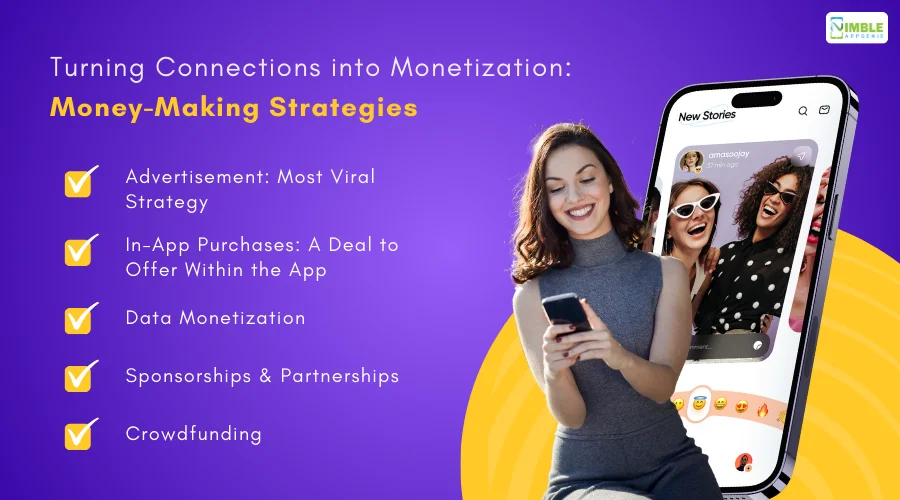
Here are some of the app monetization strategies to be considered in this custom development guide for a social media app.
♦ Advertisement: Most Viral Strategy
How do popular social media apps create money? Well, advertising is the greatest source for them. It offers both free and paid versions of ads.
Over this monetization strategy, you should provide a space to the brands for advertising and can charge a fee in exchange. This can become a permanent source of income for your social media app.
♦ In-App Purchases: A Deal to Offer Within the App
You should create a social media app with an in-app purchase monetization framework. This method can help in encouraging the users to buy features that may help them to engage successfully.
An optional purchase option within the app is useful for retaining users’ interest and increasing brand loyalty.
♦ Data Monetization
Data monetization assists in leveraging users’ data obtained with consent for diversified purposes that can help generate revenue.
With this process, you can evaluate users’ data and analyze it or trade it in exchange for money. This will decrease the overall cost of operations.
♦ Sponsorships and Partnerships
Discover the best monetization strategies for your mobile app. Sponsorships and partnerships would be of interest.
You can monetize sponsorships via referral programs and revenue-sharing programs. Connecting with firms who can provide you with permanent revenue will be a boon.
♦ Crowdfunding
If your brand is new to the market, then crowdfunding is the best way to monetize the app. Here you can raise funds from the public.
This is a convenient way to earn money and to gain the public’s attention, as well as to aware them of the brand.
These were some of the app monetization strategies to consider.
If you are still puzzled, connecting to an experienced firm can help.
Building Social Media Dreams: Why Choose Nimble AppGenie?
Puzzled about selecting a company that can help you throughout the development process?
Nimble AppGenie can be your partner in this journey. We are the best social media app development company with years of experience and a skilled individual team.
Our experts can assist you in this process as we are aware of the current market scenario and know well how to deal with your project.
Conclusion
To build a social media app, you should be aware of the effective process. The right steps to create a social media app start with market analysis, identifying the right audience, and ending with launching the app. Here, you should note to include effective features for your apps such as secure log-in, content sharing, open forums, AR filters, live streaming, push notifications, search features, and more.
There are different types of social media apps that you can create such as livestreaming, discussion forums, video platforms, peer-to-peer social platforms, and private networking. You can overcome these issues to develop a social media app by adopting effective strategies.
Other than this, you can earn money from the app by implementing different monetization strategies such as data monetization, advertising, advertising, crowdfunding, etc. Connecting with a reputable firm can help you here.
FAQs
Steps to develop a social media app include:
- Conducting market research.
- Identifying target users.
- Choose a platform (iOS, Android, or hybrid).
- Select an app development team.
- Creating a Minimum Viable Product (MVP).
- Select core and advanced features.
- Designing a trendy UI/UX.
- Choose the right tech stack.
- Developing the front-end and back-end.
- Testing the app.
- Launch and maintaining the app.
Various types of social media apps include:
- Traditional social networking apps (e.g., Facebook, Threads).
- Image-based apps (e.g., Instagram, Pinterest).
- Video sharing/streaming platforms (e.g., YouTube, TikTok).
- Livestream social media (e.g., Twitch, Instagram Live).
- Discussion forums (e.g., Quora, Reddit).
- Private networking hubs (e.g., Slack, Discord).
- Peer-to-peer social platforms (e.g., WhatsApp, Skype).
Building a social media app can:
- Create brand awareness.
- Meet growing user demand.
- Bring on a revolution by filling market gaps.
- Connect users and foster relationships.
- Generate revenue through various monetization strategies.
- Provide a source of entertainment.
Essential features for a social media app include:
- Secure login.
- Content sharing.
- Push notifications.
- Eye-catching user interface.
- Search functionality.
- Implementation of artificial intelligence.
- Gamification elements.
- Platform integration.
- Live video streaming.
- Augmented reality (AR) filters.
- Open forums.
- Real-time analytics.

Niketan Sharma is the CTO of Nimble AppGenie, a prominent website and mobile app development company in the USA that is delivering excellence with a commitment to boosting business growth & maximizing customer satisfaction. He is a highly motivated individual who helps SMEs and startups grow in this dynamic market with the latest technology and innovation.
Table of Contents




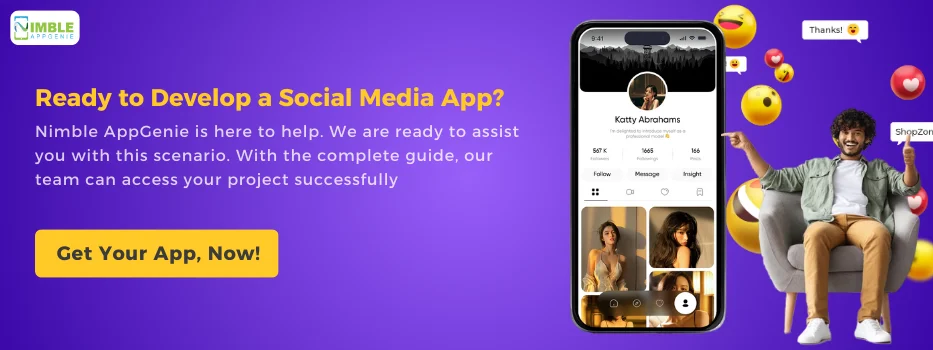
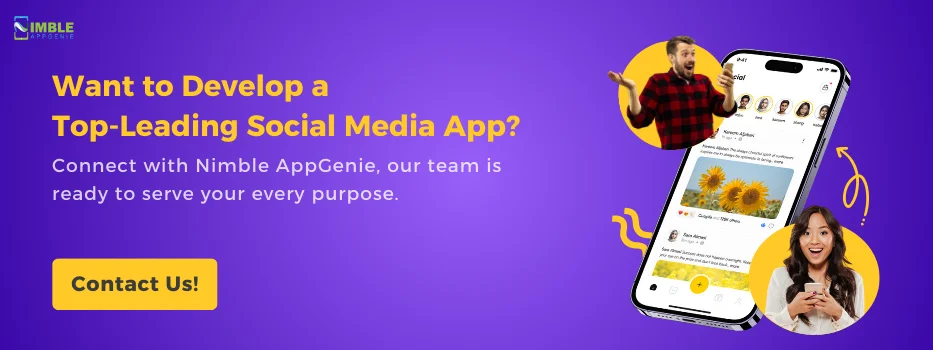
No Comments
Comments are closed.